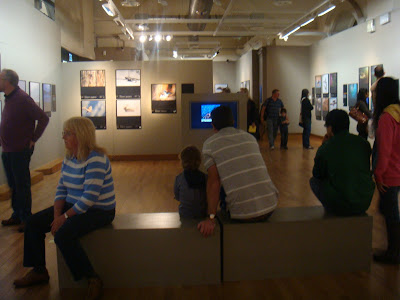 |
| 周末,一家大小逛博物馆。 |
二月19日到六月5日在Bristol Museum and Art Gallery展出“Wild Life Exhibition”。展出的作品都是经过比赛挑选出来的,都是很棒的作品。今天刚好有个评审带我们逛展览,介绍的同时她也透露了一些她对照片的审美观。依稀记得其中几点:照片要耐看,让你看了又看,越看越有味道;看事物要用创意的角度;挑选照片的时候,美感至上,所以得出的结果会是相当的主观。这个影展的主题是“Wild Life”,是我非常关心的课题,同时也让我好想回到热带雨林看看动植物朋友们过得如何。接着跟大家分享一下影展的佼佼者如何用镜头说故事,用照片秀创意。
p/s以下照片都是在影展上翻拍的,有的照片照不全,有的照片色彩有差,有的照片角度倾斜,造成失真,深感抱歉。Photographs and words below are copied from the exhibition.
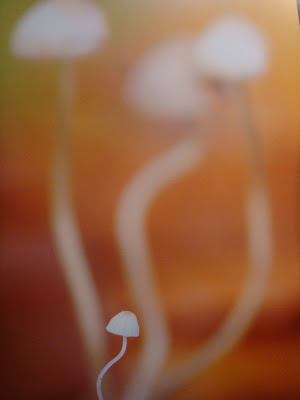
Frederic Demeuse (Belgium)
“I made the tiniest toadstool the main subject of the composition, positioning it so that its shape was echoed by the big central one behind – a projection of what the little one would look like very soon. It was a gift from nature.” The Sonian Forest is an ancient woodland dating back to at least the middle ages. Fungi are a key part of the ecosystem in deciduous woodlands such as this one, decomposing dead plant and animal matter on the forest floor. They absorb food by secreting digestive enzymes into it, breaking down larger molecules until they are small enough to be absorbed. (Belgium)
Technical details
Nikon D300 + 105mm f2.8 lens; 1/10 sec at f5.6 (+0.3 e/v);
ISO 250; tripod + Rotule ballhead + angle viewfinder +
mirror- locked and ML-3 remote control.
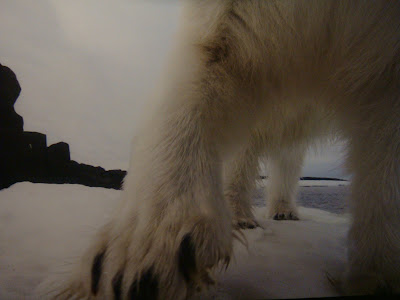
Eirik Gronningsaeter (Norway)
“I spotted this polar bear close to shore and carefully set up my camera on the snow nearby. The moment I got back to the boat, it started to investigate the camera, even walking around with it in its mouth. When the bear had gone, I returned to pick up the camera and was surprised it was still in one piece, with not even a scratch on the coating.” Polar bear are extremely inquisitive. They have an excellent sense of smell and can sniff out a seal from up to 20 kilometres away. The bears rely on this excellent sense of smell and their sensitive lips and whiskers to explore objects. (Norway)
Technical details
Canon EOS 40D +
10-16mm f.2.8 lens;
1/250 sec at f13; ISO 640;
remote control.

Jochen Schlenker (Germany)
“I travelled to the French Alps specifically to take photographs of ibex. When I saw the interesting cloud formations and the jagged mountains reflected in the smooth surface of Las Des Cheserys, I knew I’d found a good spot ibex walked by in the distance, it completed the image.” The ibex is a species of wild goat, well adapted to the steep, rocky terrain of the Mont Blanc region. Female ibex live in 10- to 20- strong maternal herds, while the males roam separately, either in bachelor groups or alone. (France)
Technical details
Nikon D300+ 16-85mm
f3.5-5.6 lens + polarizer
+ 1- stop ND grad filter;
1/100 sec at f8; ISO 200;
cable release; tripod.
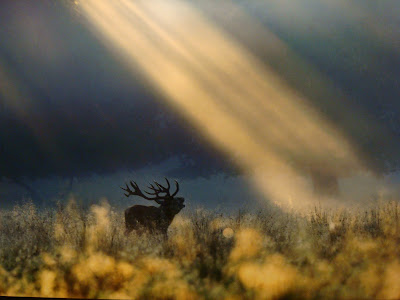
Pierre Vernay (France)
“To catch the action of the rut, I planned to photograph the deer backlit against the rising sun. As the first beam of sunshine lit up the grass, a stag emerged from below a huge oak tree to challenge a contender for its territory. One set of bellowing was enough. The rival got the message loud and clear, and vanished. ” The roar of a red deer stag carries an unmistakable message; the more powerful the roar, the stronger the stag. Designed to carry sound through the forest, the call leaves both hinds and competitors in no doubt about the caller’s location and physical superiority. (Denmark)
Technical details
Nikon D3+ 500mm f4 lens;
a/640 sec at f6.3; ISO 800.
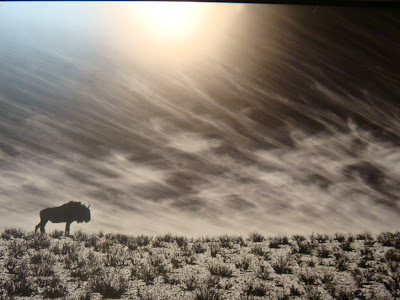
Morkel Erasmus (South Africa)
“I couldn’t believe my luck when a lone blue wildebeest wandered into this scene and posed against the dramatic backdrop. I wanted to celebrate the wildebeest as a desert survivor caked in dust, constantly on the search for food and water, dodging the onslaught of predators.” The blue wildebeest is famous for forming vast migratory herds. Males separate from these herds when they are a year old and join a group of bachelors. At about our years old, they become solitary and attempt to win a territory. Using displays and loud calling near the stationary herd of females, the males will vie for attention in order to mate. (South Africa)
Technical details
Canon EOS 1000D +
18-55mm lens; 1/250
sec at f16; ISO 200.
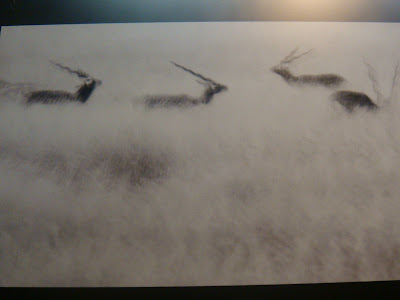
Nilanjan Das (India)
“It was almost dusk when the storm started. At one point, the wind was so strong that I could barely stand up. By then, there was almost no visibility, but all of a sudden, out of the swirling dust emerged a group of blackbuck, oblivious to my presence.” When blackbucks are alarmed, a single animal will bound high into the air and is soon followed by others until the whole herd is moving. These bounds continue for a few strides before the herd begins to gallop, and speeds of up to 80 kilometres an hour have been recorded. (India)
Technical details
Nikon D300 + Sigma
70-200mm f2.8 lens;
a/10 sec at f7.1; ISO 800.
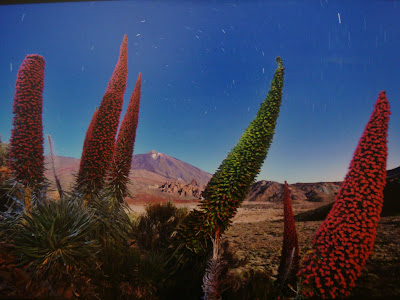
Francisco Mingorance (Spain)
“Volcanoes create a world in which everything is exceptional, virgin and wild. I spent many days looking for the right grouping of plants, finally discovering this clump. The Mount Teide volcano provided the perfect backdrop, and I positioned my tripod so the North Star would appear just above the crater.” Millions of years of physical isolation have led to the evolution of many novel species on the Canary Islands. The rare red bugloss is considered a floral treasure, symbolic of the unique wildlife of these islands. (Spain)
Technical details
Nikon D3 + 14-24mm
f2.8 lens; 637 sec at f5;
ISO 200.
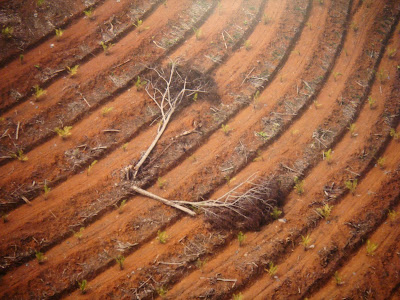
Daniel Beltra (Spain)
“I have been documenting the destruction of the world’s rainforests for more than 10 years now, focusing on the impact of deforestation on global warming. I want my photography to highlight how crucial it is to preserve these rich ecosystems, and to inspire people to make changes to protect them.” Indonesia already has six million hectares of palm oil plantations, but has plans for another four million by 2015. Palm oil is now used in half of all consumer goods, from cosmetics to biofuels. The cost to Indonesia’s biodiversity, as well as global climate, is high and the country now has one of the fastest rates of deforestation in the world. (Indonesia)
Technical details
Canon EOS 5D Mark II + 100-400mm f4.5-5.6 lens;
1/1000 sec at f5.6; ISO 500.
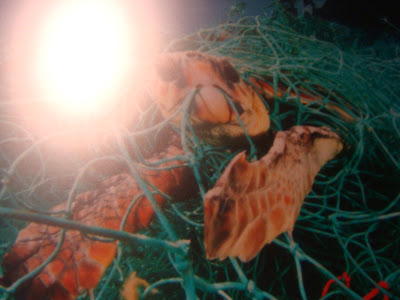
Jordi Chias Pujol (Spain)
“I spotted an abandoned net drifting along the surface, with a loggerhead turtle tangled up in it. The poor creature must have been trapped for some days, but was still alive, so I dived down to investigate. I felt it was looking at me for help as it tried to bite through the netting. I released it, giving it a second chance for survival.” Getting tangled in nets is a common fate for loggerhead turtles, not only here in the Mediterranean, but also worldwide. Human activities continue to threaten turtle populations and all species are now endangered. (Mediterranean Sea)
Technical details
Nikon D300 + Tokina fisheye 10-17mm f3.5-4.5 DX lens;
1/160 sec at f14; ISO 200; housing; Inon strobes.
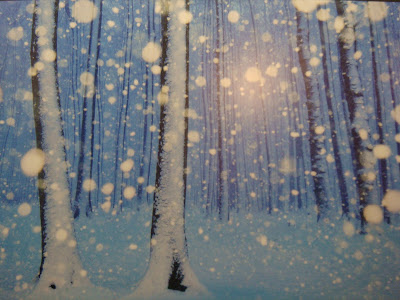
Sandra Bartocha (Germany)
“I’d always imagined a dreamy image with a lot of out-of-focus flakes in the foreground and this was the perfect situation. It was quite dark by the time it began to snow very heavily, so I adjusted my camera settings to create the surreal composition of trees disappearing into a curtain of magical snowflakes.” Buffeted by winds from the Baltic Sea, Gespensterwald is an old beech forest near Nienhagen, Germany. The conditions here have contributed to the lack of ground cover and the forest’s reputation as a spooky place, giving rise to its name, which means ghostly forest. (Germany)
Technical details
Nikon D700 + 24-70mm f2.8 lens;
0.8 sec at f5.6; ISO 200; internal flash.
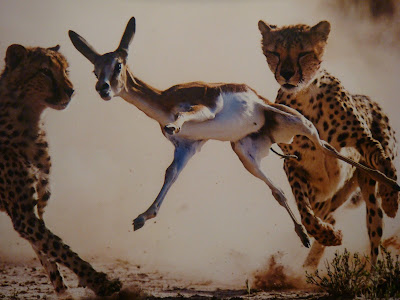
Bridgena Barnard (South Africa)
“I arrived with my camera at sunrise to find three cheetahs already in position on the dunes, with only the tops of their heads visible. When a young springbok passed by below, the trio of brothers sprinted after it, working in unison to head it off, trip it up and crush its windpipe, all in the space of 10 seconds.” Cheetahs are the fastest mammals over short distances, reaching speeds of up to 112 kilometres an hour. Because they cannot run this fast for more than about 500 metres, they covertly stalk their prey before sprinting full pelt from only 30 metres away. (South Africa)
Technical details
Nikon D700 + 500mm f4 lens + 1.7 converter;
1/4000 sec at f6.7; ISO 1600.
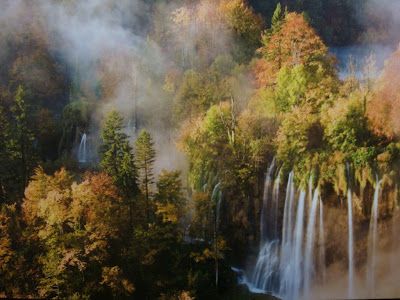
Maurizio Biancarelli (Italy)
“After two frustrating days of torrential rain, everything came together in the most serendipitous way: beautiful colours on the lush, mixed woods, golden light and fog banks waving over lakes and waterfalls. I especially like the dream-like quality of this image.” The beautiful Veiliki Prstvaci waterfalls and the surrounding lakes are renowned for their distinctive colours, which change constantly depending on the number of minerals and organisms in the water, and the way the sunlight hits the surface.
Technical details
Nikon D3 + 24-70mm f2.8 lens; ¼ sec at f11;
ISO 200; Gitzo 3540 tripod.
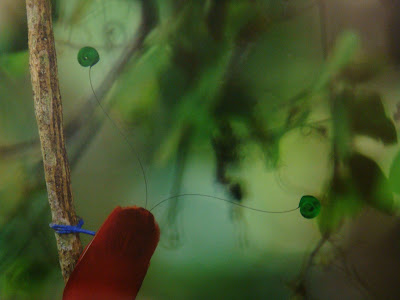
Tim Laman (USA)
“I have a real passion for birds of paradise. I wanted to highlight the male’s distinctive features, especially those tail wires and the blue legs contrasting with the brilliant-red body.” The king bird of paradise is the smallest, yet most brightly coloured, member of the bird of paradise family. During their courtship display, males will spread their wings, hang upside down and vibrate their tail feathers – tipped with metallic green discs – at prospective females. (Indonesia)
Technical details
Canon EOS 5D Mark II + 600mm f4 lens;
1/180 sec at f5.6; ISO800.
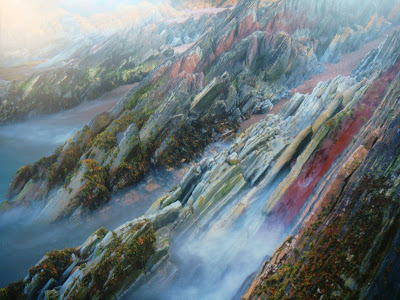
Verena Popp-Hackner (Austria)
“Every time I visited, a new combination of light, tide and weather made the seaweed-covered rocks look different. Some colours were stronger when the rock was wet and some reflected indirect sunlight well, while others were better in shade. On this day, the colour combination was pure magic.” This amazing coastline on Norway’s Varanger Peninsula is made up of sandstone, quartzite and red shale. More than 300 million years before dinosaurs appeared on Earth, these reptile-like ridges were being shaped by glaciation and weathering that continues to this day. (Norway)
Technical details
Toyo Field 45 AII + Schneider 75mm f5.6 lens;
8 sec at f45; Fujichrome Velvia 50.
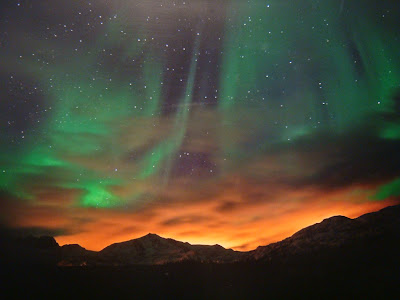
Kent Miklenda (Australia)
“I went to the Lofoten Islands because I wanted to include the spectacular landscape in my photos. This was my first real experience of the aurora borealis and it was sublime. Standing under the brilliant roof of stars and shimmering curtains of light was evocative of being in a kind of celestial cathedral. Experiencing it filled me with awe and reverence for the world.” The natural physics behind this phenomenon is impressive. It involves atomic collisions of the solar winds and Earth’s magnetic field lines, creating ionizing gases that flux and glow in the atmosphere. (Norway)
Technical details
Canon EOS-1Ds Mark III; 16-35 L lens;
38 sec at f/2.8; ISO 400; Manfrotto 555B tripod and ballhead; Radio remote shutter release.
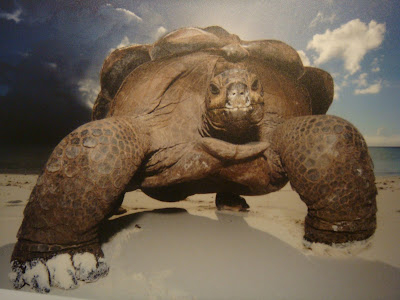
Thomas P Peschak (South Africa/ Germany)
“This female tortoise, probably at least 100 years old, regularly forages along the beach in front of a research station on Aldabra. The moment I took the shot, I had to roll out of its way to avoid the enormous animal clambering right over me.” Aldabra giant tortoises tend to spend their lives grazing on low- level vegetation, but will cover surprising distances in search of food. They have been known to eat carrion or wander onto beaches to eat washed-up seedpods. Rising sea levels caused by global warming, and the very low-lying land on the atoll, now present a new threat to these ancient animals. (Seychelles)
Technical details
Nikon D3 + 14-24mm lens; 1/200 sec at f22;
ISO 200; Nikon SB800 flash.
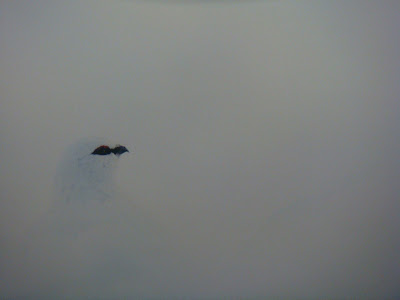
Fergus Gill (UK)
“The Scottish mountains in midwinter are both beautiful and remarkable, and without question my favourite place to be. I have such respect for the animals able to survive here, and none more so than the rock ptarmigan. I love the simplicity, the subtle light caught in its eye and the hint of red wattle above.” The rock ptarmigan is native to the high mountain areas of Scotland. In winter, the bird’s plumage changes to white- a cunning camouflage that helps to protect it from predators. When the ptarmigans moult in summer, they turn a mottled grey-brown and white colour. (Scotland, UK)
Technical details
Nikon D300 + 500mm f4 lens; 1/400 sec at f5.6; ISO 400.
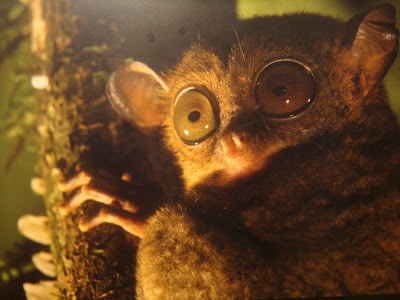
Tim Laman (USA)
“I had been out searching for western tarsiers many times on my trips to Borneo, but this was my first sighting in more than 20 years. I kept my flash toned down and at an angle to illuminate the tarsier’s special features.” Tarsiers are nocturnal, their huge eyes designed for night vision. Equipped with ears so sensitive they can detect prey by hearing alone, their toe pads are ideal for clinging to trees, making them perfectly adapted to life in the understory, hunting for insects. (Malaysia)
Technical details
Canon EOS 5D+ 70-200mm f2.8 lens; 1/125 sec at f11; ISO200; Canon 580EX strobes.
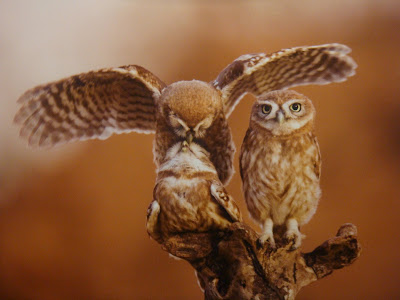
Ilia Shalamaev (Israel)
“I stationed my hide near nesting holes in the 20-metre-high walls of this abandoned quarry and soon noticed the owls loved to perch on one particularly big rock. I dragged an even bigger branch to the same spot and the owls quickly preferred the better vantage point. I was then able to photograph the chicks to my heart’s content.” Little owls are the most common and widely distributed owls in Israel. Very vocal birds, they can be heard calling to each other in daylight, although they are most active at night. Rather than hunting on the wing, they pounce on prey from perches in open areas of land. (Israel)
Technical details
Canon EOS 5D + 500mm f4 lens + 1.4x converter;
1/250 sec at f5.6; ISO 400; Gitzo tripod; hide.
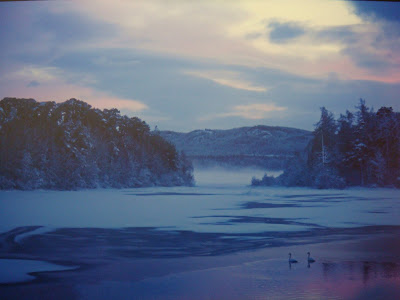
Sam Cairns (UK)
“I was photographing a mountain scene when I sensed a beautiful sunset beginning to form. So I dashed over to nearby Loch Insh where I knew there were some mute swans. I set up my camera on the bridge and captured this winter scene as the colour developed in the sky.” The prolonged periods of sub-zero temperatures during Scottish winters make life very difficult for mute swans/ Although hardy, these birds need some ice-free water in order to feed, which they do by plunging their long neck and head beneath the surface. (Scotland, UK)
Technical details
Canon EOS-1Ds Mark II + 24-105mm lens;
1/20 sec at f4; ISO 500; Gitzo tripod.
影展还有许多照片我没放上来,这些都是印象比较深刻,比较有感触的相片儿。相关的思绪,日后经沉淀再写一篇。今晚也特别想念那段爬山涉水跟踪发现野生动物的日子。这些相片都让我惊叹不已,更何况是那位创造这一切的上帝。脑中忽然响起BICF常唱的一首歌儿:
“Beautiful one I love
Beautiful one I adore
Beautiful one my soul must sing. ”
Beautiful one I adore
Beautiful one my soul must sing. ”
Comments
wow~~~好漂亮哦
如果你们说的话,我还真以为是有photoshop的
@Drumho 真的震撼~ 第一次看的时候,不断出现惊叹号。第二次看的时候,就决定要和更多的人分享。大自然真的很漂亮,有些景色是我们一般上不会有机会看到,不过能看到图片也很不错了。评审说比赛允许调照片,当然是有限制的调。可是我也不太清楚到底调了什么。